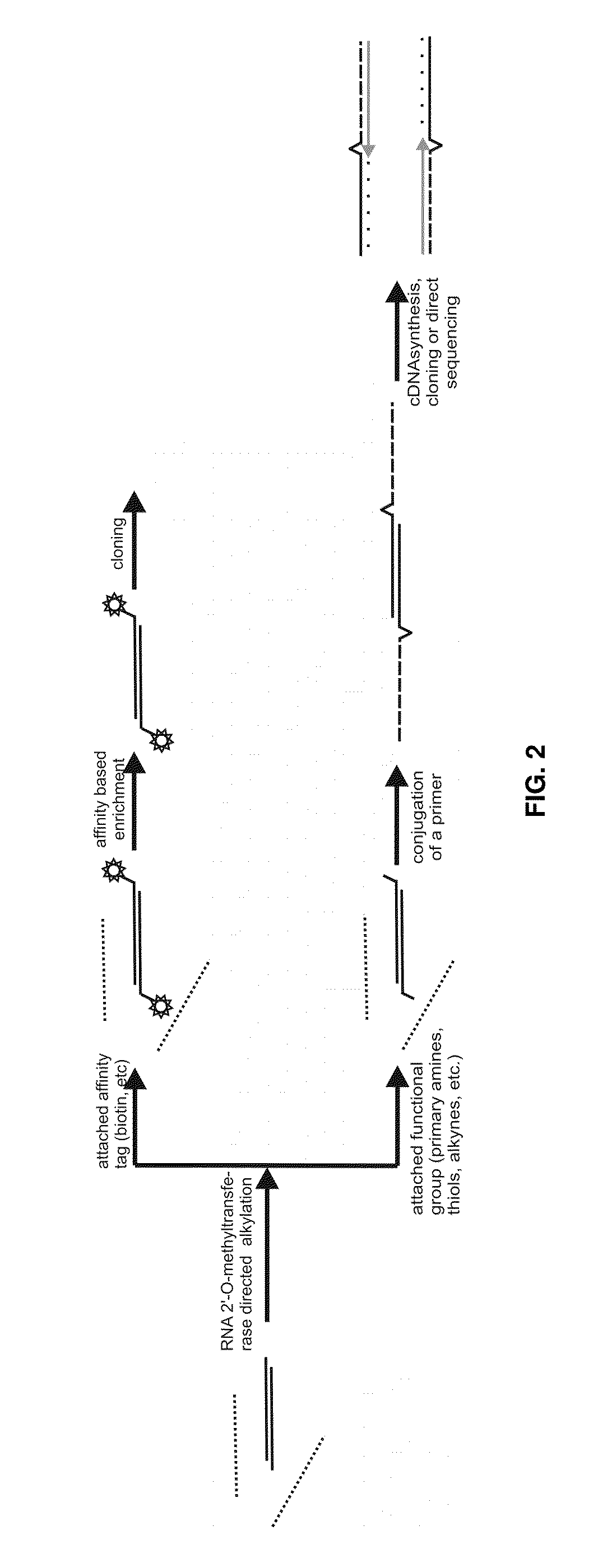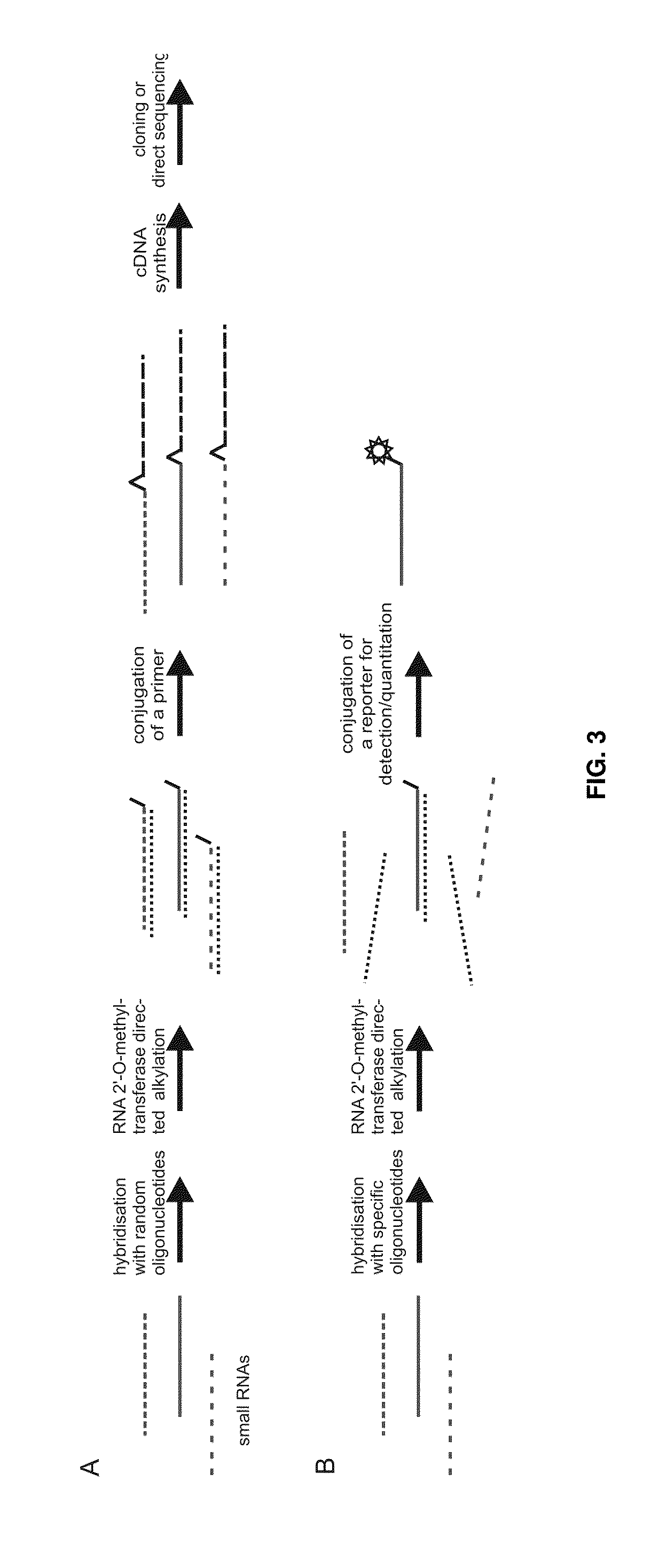Analysis of small RNA
a technology of rna and analysis method, which is applied in the field of analysis of small rna molecules, can solve the problems of inefficient transfer to the membrane, inability to detect undeired labelling, and inability to detect 24 nt rna, so as to reduce the possibility of undeired labelling, reduce the possibility of nuclease contamination, and improve the resistance to rna degradation
- Summary
- Abstract
- Description
- Claims
- Application Information
AI Technical Summary
Benefits of technology
Problems solved by technology
Method used
Image
Examples
example 1
HEN1-Dependent Modification of Short miRNA Duplexes Containing Two-Nucleotide 3′-Overhangs
[0099]The results of Example 1 are shown in FIG. 4, which demonstrates HEN1-dependent alkylation of double-stranded RNA substrates (miR173 / miR173* and miR210 / miR210*) resembling plant and animal natural microRNA. In these gel photographs the strand labeled with 33P (to be visualized) is marked in Bold. Solid arrows point at bands corresponding to modified RNA strands; dotted arrows point at unmethylated RNA strands.
[0100]In FIG. 4A it was demonstrated that HEN1-mediated coupling of side chains on double-stranded RNA was appropriate for either two-step (through primary amine from Ado-6-amine, lane 2) or one-step labeling (through Biotin reporter from Ado-biotin, lane 3) schemes. Experiments using 0.2 μM synthetic 33P-miR173 / miR173*duplex (miR173 was radiolabeled with phosphorus-33 isotope) were performed for 1 hour at 37° C. with 100 μM synthetic cofactors either in the presence of 1 μM HEN1 or ...
example 2
HEN1-Dependent Modification of RNA Strands in Short Heteroduplex Substrates
[0104]The results of Example 2 are shown in FIGS. 5, 6, 7 and 8, which demonstrate the ability of the enzyme HEN1 to transfer a modified group (either a functional group or a reporter group) to unnatural RNA / DNA and RNA / LNA heteroduplexes.
[0105]The gel photos in FIG. 5 show the result of the modification of RNA / DNA (FIG. 5A) and RNA / LNA (FIG. 5B) with two-nucleotide 3′ overhangs, with HEN1.
[0106]Further results from experiments with RNA / DNA heteroduplexes are shown in FIGS. 6 to 8. In particular, FIG. 6A shows the two-step labeling of miR-26a* / DNA-26a*. A similar covalent two-step labeling of an miRNA / miRNA* duplex with a fluorophore is shown in FIG. 6B, FIG. 6C demonstrates the one-step labeling of RNA strands in an RNA / DNA heteroduplex with biotin.
[0107]FIG. 7 provides results of experiments demonstrating that modification and one-step labeling of RNA strands can be directed to RNA / DNA heteroduplexes that c...
example 3
HEN1-Dependent DNA-Directed Modification and Labeling of Short RNA Strands in RNA Pools
[0109]Example 3 demonstrates HEN1-dependent DNA-directed modification of short RNA strands in RNA pools, the experimental strategy for which is shown in FIG. 11. The results are shown in FIGS. 9 and 10. FIG. 9 shows the modification of miR173, miR-26a* and let-7a-2** by HEN1 after hybridization to complementary DNA. This demonstrates that 2′-O-methyltransferase-dependent modification can be directed by a DNA probe to a specified RNA strand in the presence of other RNAs resembling of plant and animal RNA.
[0110]FIG. 10 shows that 2′-O-methyltransferase-dependent labeling can be selectively directed by a DNA probe to a specific RNA strand in the presence of total cellular RNA of bacterial or animal origin. In FIG. 10A single stranded miR173 or let-7a-2* is premixed with total RNA from E. coli in the presence of complementary DNA and the ability of HEN1 to modify the miR173 or let-7a-2* strands using ...
PUM
| Property | Measurement | Unit |
|---|---|---|
| pH | aaaaa | aaaaa |
| pH | aaaaa | aaaaa |
| pH | aaaaa | aaaaa |
Abstract
Description
Claims
Application Information
 Login to View More
Login to View More - R&D
- Intellectual Property
- Life Sciences
- Materials
- Tech Scout
- Unparalleled Data Quality
- Higher Quality Content
- 60% Fewer Hallucinations
Browse by: Latest US Patents, China's latest patents, Technical Efficacy Thesaurus, Application Domain, Technology Topic, Popular Technical Reports.
© 2025 PatSnap. All rights reserved.Legal|Privacy policy|Modern Slavery Act Transparency Statement|Sitemap|About US| Contact US: help@patsnap.com



